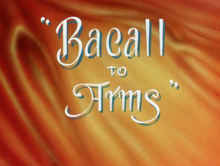Bacall to Arms
| Bacall to Arms | |
|---|---|
 | |
| Directed by | Bob Clampett Arthur Davis |
| Story by | Warren Foster Michael Sasanoff |
| Music by | Carl Stalling |
| Animation by | Manny Gould Rod Scribner Don Williams I. Ellis |
| Layouts by | Thomas McKimson |
| Backgrounds by | Philip DeGuard |
| Color process | Technicolor |
Production company | |
| Distributed by | Warner Bros. Pictures |
Release date |
|
Running time | 6:11 |
| Language | English |
Bacall to Arms is a 1946 Warner Bros. Merrie Melodies series short planned by Bob Clampett and finished by Arthur Davis, in his second-to-last cartoon at Warner Bros.[1] The short was released on August 3, 1946.[2]
The title refers both to Hemingway's 1929 novel A Farewell to Arms and actress Lauren Bacall, whose acclaimed 1944 film debut was in To Have and Have Not, based on Hemingway's 1937 novel, as well as a play on the term "a call to arms".
Plot
The cartoon is set in a
The main feature is a film called To Have- To Have- To Have- ..., a parody of To Have and Have Not. It includes images of Humphrey Bogart and Lauren Bacall, who are credited as "Bogey Gocart and Laurie Bee Cool". In addition to recreating a few well-known scenes from that film (the kissing scene; the "put your lips together and blow" scene), the players sometimes lapse into slapstick (Bacall lighting her cigarette with a blowtorch à la Harpo Marx; or letting loose with a loud, shrill whistle after her famous sultry comment) and interact with the theater audience.
Although the theater was initially full, it is eventually seen to be empty except for one patron: a literal lone wolf in a
Analysis
The film reuses animation from an earlier short,
The film functions as a tribute to Bacall and her
The distinctive voice of
Author Don Peri points that in the 1930s,
World War II ended in September 1945, but several animated shorts released later in that year and into 1946 still contained war-related references. In Bacall to Arms there is a newsreel featuring "wartime inventions put to peacetime use". The example depicted is that of a married man who uses a radar to receive early warnings for the unannounced visits of his mother-in-law.[9]
The house in the Newsreel segment was the same house used in the Private Snafu short Payday, a short where Snafu keeps buying unnecessary items rather than investing money on that house when the war was over.
Norman Klein cites the film as an example of animated films referencing film noir and figures associated with the genre, such as Bogart. He argues that screwball comedy film, the chase-themed animated films, the crime film, and film noir were genres which shared certain elements. In his view, all were reactions to the melodrama films of the 1930s and all rejected the moralizing tendencies of these melodramas. They reacted by embracing depictions of outrageous behavior and amorality. Common themes among them were the depiction of poetic justice as malum in se, of faked sentiment as a tool of deception, and sardonicism as the primary form of humor.[10]
Home media
- Bacall to Arms is available, uncensored and uncut, on Looney Tunes Golden Collection: Volume 5, Disc 3.
- Also available as bonus feature on the DVD issue of To Have and Have Not (Region 1 and 4)
- It is also available on "The Golden Age Of Looney Tunes Volume 2" laserdisc.
Sources
- Barrier, Michael (1999), "Warner Bros.,1941-1945", Hollywood Cartoons: American Animation in Its Golden Age, ISBN 978-0199839223
- Crafton, Donald (1998), "The View from Termite Terrace: Caricature and Parody in Warner Bros. Animation", in Sandler, Kevin S. (ed.), Reading the Rabbit: Explorations in Warner Bros. Animation, ISBN 978-0813525389
- Kanfer, Stefan (2011), "Cut the Gab and Bring Me an Order of Fried Rabbit", Tough Without a Gun: The Extraordinary Life of Humphrey Bogart, ISBN 978-0571260744
- Klein, Norman M. (1996), "Citizen Kane, the Cartoon: Screwball Noir, 1941-46", Seven Minutes: The Life and Death of the American Animated Cartoon, ISBN 978-1859841501
- Lehman, Christopher P. (2009), "United Productions and the End of Animated Black Representation", The Colored Cartoon: Black Representation in American Animated Short Films, 1907-1954, ISBN 978-1558497795
- Peri, Don (2011), "Xavier (X.) Atencio", Working with Disney: Interviews with Animators, Producers, and Artists, ISBN 978-1604739404
- Sartin, Hank (1998), "From Vaudeville to Hollywood, from Silence to Sound: Warner Bros. Cartoons of the Early Sound Era", in Sandler, Kevin S. (ed.), Reading the Rabbit: Explorations in Warner Bros. Animation, ISBN 978-0813525389
- Shull, Michael S.; Wilt, David E. (2004), "Slow Fade on the Home Front: 1944-1945", Doing Their Bit: Wartime American Animated Short Films, 1939-1945, ISBN 978-0786481699
- Worland, Rick (2011), "Humphrey Bogart and Lauren Bacall: Tough Guy and Cool Dame", in Griffin (ed.), What Dreams Were Made of: Movie Stars of the 1940s, ISBN 978-0813549637
References
External links
- Bacall to Arms at IMDb
